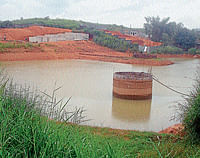
Perhaps Dakshina Kannada is the only district in Karnataka to have maximum number of quality educational and medical institutions and Yenepoya University is one among them.
Emboldened by the overwhelming positive response of the community and the students, the management perceived a need to develop into a University, where autonomy and self reliance would place the institutions on the global map and would internally motivate them to higher levels of excellence. Ever since the deemed university was formed in 2008, the university has been adding several feathers to its cap.
Among the many novel initiatives taken up by the university, the state of the art rainwater harvesting project set up in the sprawling 2.25 acres of plot in the university premises in Deralakatte has not only helped the university save a huge amount on water, but also helped the 200-odd surrounding houses in the villages in solving their water problems due to steep increase in underground water table.
Untill the rainwater project was set up, the university used to spend an average of Rs 7 lakh a month on water supply to the university premises as the three borewells in the university premises could not meet the water requirement.
“One fine day, the university authorities learnt about P K Thampy, a retired officer of Geological Survey of India, who has done commendable job in rainwater harvesting projects in Kerala. Without wasting any time, the university contacted him and the rest is history,” says Dr Ravi Vaswani, former registrar and a professor of Medicine at the Yenepoya University.
The rainwater harvesting tank has been set up in the lowest point in the entire 34-acre campus. And all the water received in the campus in the form of rain, flows to the 4 crore litres capacity tank through underground pipes. “In spite of lifting an average of 5 lakh litres of water everyday for hospital, college and hostels to meet the requirements of more than 4,000 people, the tank provides water for about 7 months,” Dr Vaswani noted.
Rise in water-level
Interestingly, the novel project has helped 200-odd houses in the vicinity. “Earlier, the open wells used to dry in summer. But after the rainwater harvesting tank was set up, no open well in the vicinity goes dry in summer. On the contrary, the water-level has substantially increased,” observed Aboobakker, the maintenance engineer at the University.
2 STPs
Besides the rainwater storage tanks, the varsity has two huge sewage treatment plants (STPs) of 2 lakh litres capacity each. “The treated water is used for flushing in toilets and gardening,” Aboobakker informed and added that 33 per cent of the 34-acre campus is covered with greenery. Even the sludge is used as manure for coconut plantation and gardening.
Paved paths
Another unique feature of the varsity is the paved paths. All the roads in the campus are designed using cobblestones. “The eco-friendly and sturdy paths designed using cobblestones not only give a different look, but also act as speed-brakers to zooming mobikes of students,” Dr Vaswani says in a lighter vein and adds that the roads do not require maintenance for a minimum of 100 years. At a time when the region suffers water-shortage, especially in summer, its time for other institutions to take a cue from the Yenepoya university, which has carved a niche in the environment management system.